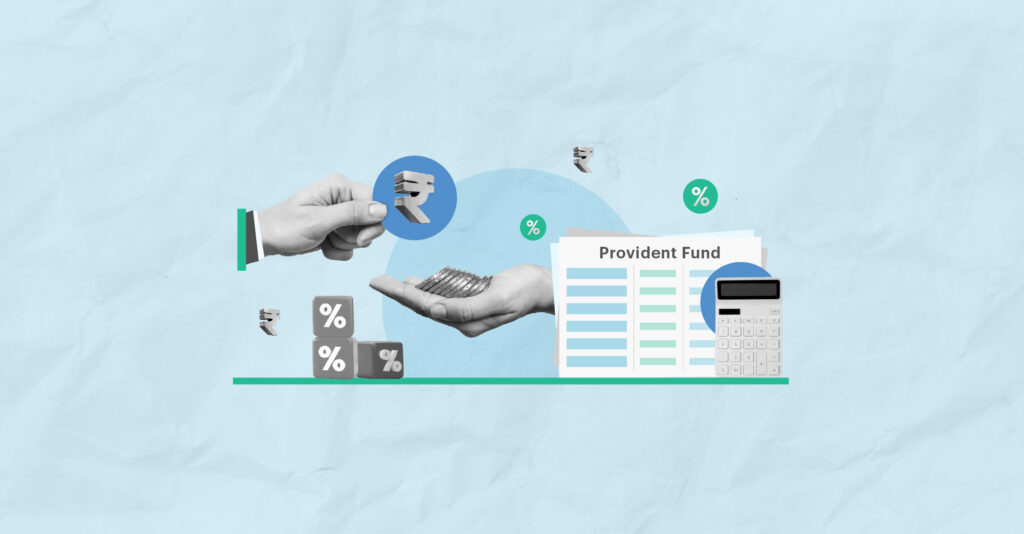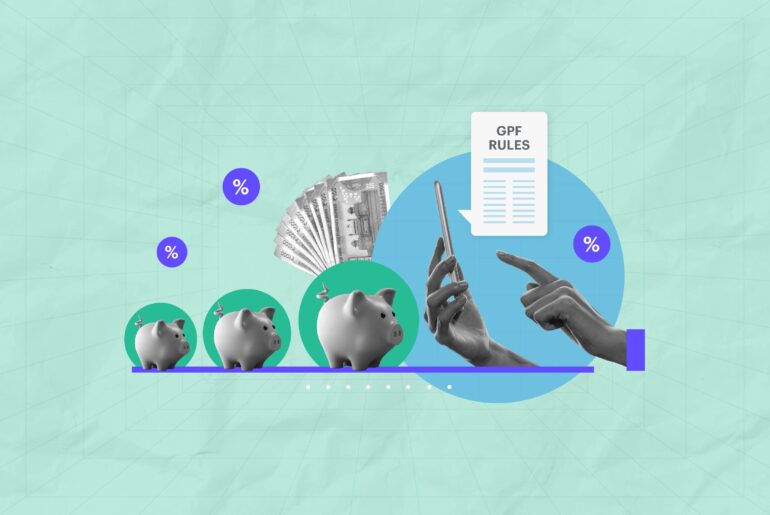Last Updated on May 1, 2023 by Komal Roy
Provident Fund (PF) is a government-backed saving scheme to encourage government and private organisations’ employees to save for retirement. The monthly contributions to the PF are deposited at the Employee Provident Fund Organisation (EPFO).
There are three parts to the PF: Employees’ Provident Fund (EPF), Employee Pension Scheme (EPS) and EDLI (Employees Deposit Linked Insurance Scheme). In the Employees’ Provident Fund (EPF), the contributions are made by both the employer and the employee. While in EPS and EDLI, only the employer contributes towards the PF. In this article, learn more about PF contribution break up and how to calculate it.
Table of Contents
PF contribution break up
Here’s a table of PFs and their contribution percentage from the employees and employers.
| Contribution towards | Employee’s contribution (in %) | Employer’s contribution (in %) |
| EPF | 10 or 12 | 3.67 |
| EPS | – | 8.33 |
| EDLI | – | 0.5 |
- The employee’s contribution of 12% of the monthly salary is deposited in the provident fund account.
- The employer’s contribution of 12% includes 3.67% of EPF and 8.33% of EPS.
- Along with the EPF and EPS, the employer must contribute an extra 0.5% to the EDLI.
Key points of PF contribution break up – employer
As per the Employees Provident Fund Act, 1952, organisations with more than 20 employees are allowed to provide EPF to their employees with a monthly salary of more than Rs. 15,000. However, organisations with less than 19 employees can voluntarily join PF.
Key points of PF contribution break up – employee
The minimum PF contribution of an employee is 12%. However, there are a few cases where the employee can contribute 10%:
- Organisations with a maximum of 19 employees.
- Organisations with an annual loss as compared to their net worth.
- Organizations with a pay limit of Rs. 6,500.
- Industries such as guar, coir, gum, brick, jute and beedi.
- If the Board for Industrial and Financial Reconstruction (BIFR) classified the organisation as ill.
How to calculate PF contribution?
The calculation of PF is simple and calculated using your basic salary. Let’s consider an example to understand the calculation better. Your basic salary is Rs. 25,000 (including dearness allowance).
- Employee’s EPF contribution: 12% of Rs. 25,000 = Rs. 3,000 per month.
- Employer’s EPS contribution: if the salary is less than Rs. 15,000 then 8.33% of the salary is taken. If the salary is more than Rs. 15,000, a fixed amount of Rs. 1,249.50 is contributed by the employer to EPS. Along with the fixed amount, 8.33% of the salary is calculated, subtracted from the fixed EPS amount and added the result is added to the EPF.
In our case, 8.33% of Rs. 25,000 is Rs. 2,082.50, so 2,082.50 – 1,249.50 = Rs. 833, which is the excess amount in EPS. It is transferred to the EPF account by the employer.
- Total employer’s contribution to EPF: 3.67% of the salary + excess from EPS = Rs. 917.5 – Rs. 833 Rs. 1,750.50 monthly.
- Overall, total EPF contribution is = employee’s contribution + employer’s contribution Rs. 3,000 + Rs. 1,750.50 = Rs. 4,750.50.
You can use your UAN (Universal Account Number) to log into your EPFO account and check the account balance and the contributions made to date.
FAQs
1. Is it mandatory for the employer to contribute towards the EPF of an employee?
Yes. All the employees registered with EPFO must contribute towards the EPF of the eligible employees.
2. What is the employer contribution to PF?
The employer’s monthly contribution towards PF is 3.67% for Employees Provident Fund and 8.33% for Employee Pension Scheme.
3. What is the employees’ contribution to PF?
The employees’ monthly contribution towards PF is 12% of their basic monthly salary.
4. What is the pension contribution in PF?
In the PF contributions, only the employer contributes towards pension, i.e., EPS. The contribution towards a pension in PF is 8.33% of the employee’s monthly salary.
5. Is the employers’ contribution to PF taxable?
The employer’s contribution towards PF is tax-exempt. However, if the amount is more than Rs. 7.5 lakh then it is taxable.
6. What is the minimum PF contribution?
For employers, the minimum PF contribution is 12% which can be extended voluntarily. For the employees, the minimum PF contribution is 12%.
7. What is the maximum PF contribution?
Currently, in the EPF the maximum PF contribution is 12% by the employee and employer each. However, employees can contribute more towards the PF account voluntarily.
- Best Blue Chip Mutual Funds – List of Top Large-Cap Funds - Jun 6, 2025
- List of Top Fundamentally Strong Stocks in India for 2025 - Jun 4, 2025
- IDCW vs Growth – Which Is Better? - Jun 4, 2025





